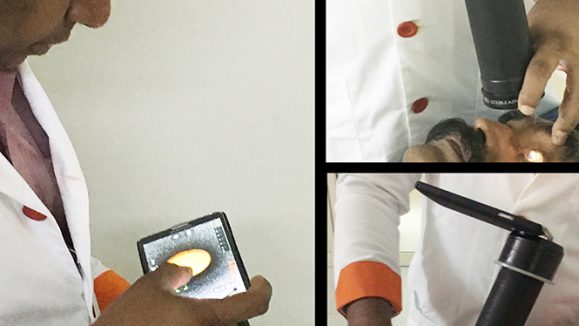Monitoring and management of age-related macular degeneration (AMD) can be taxing on patients and their caregivers, as well as the eye care team. This burden might be eased if it were possible to tell which patients need more careful monitoring, which patients may progress, or which could wait a little longer between visits. Now, the solution may not be that far away thanks to the innovators at iHealthScreen, who have recently developed a product for automatic screening and prediction of AMD.
Dr. Alauddin Bhuiyan, Ph.D., founder and CEO of iHealthScreen Inc., (USA), has been leading teams focused on artificial intelligence-based retinal and systemic disease screening. Recently, Dr. Bhuiyan and his company developed an image-based prediction tool which can identify individuals at risk of developing late AMD. “This is the first tool that can predict late AMD, non-invasively,” shared Dr. Bhuiyan. This early-detection device is powered by artificial intelligence (AI) and machine learning (ML) and is intended to be used by healthcare providers through a telemedicine platform.
This is a game-changer in AMD management. As the leading cause of vision loss in those over the age of 50 in the developed world, the number of people with AMD is expected to increase 1.5-fold over the next 10 years due to an aging population, hypertension and other causes. Dry AMD accounts for 80 to 90 percent of all AMD diagnoses, and there is currently no treatment available for its advanced form, geographic atrophy. Once detected, it is often too late to mediate the issue as too much vision has already been lost. And though treatment with anti-vascular endothelial growth factor (anti-VEGF) has revolutionized the management of neovascular (or wet) AMD, and is effective in maintaining or improving vision, it is not curative.
In addition, the costs of AMD are significant. While the direct cost of AMD is $225 billion per year, and is expected to increase due to the snowballing number of AMD cases, the indirect costs are even greater: injury, depression, and social dependency resulting from blindness. The key to lowering costs and better treatment is effective screening, early detection and early intervention.
Dr. Bhuiyan says his group at iHealthScreen has developed this software tool for family physicians and optometry clinics to use during yearly patient checkups to detect and prevent this vision threatening disease. “The tool will be used to determine (or screen) whether an individual with intermediate AMD should be referred to an ophthalmologist for further review. Utilizing the software’s prediction capabilities, the ophthalmologist will then decide whether or not to administer AREDS (age-related eye disease study) supplements or further treatment to prevent the development of late AMD.”
“The AMD screening tool can accurately identify early or intermediate stages of AMD at greater than 98 percent precision. The prediction tool can identify an individual who will likley progress from intermediate to late AMD with 83 percent accuracy or above. This is the first image-based, non-invasive model which can predict an individual’s incident of late AMD,” he added.
So, how does it work? The device uses a fundus camera to capture a patient’s high-resolution retinal images. Those are then uploaded and analyzed by an intelligent AMD screening system deployed on cloud servers. Through fundus image analysis, the user receives a detailed disease level indication analysis delivered to their choice of device almost instantaneously.
This telemedicine-based AMD disease screening system (Figure 1) has a web interface and a mobile app so that a user can get screening reports automatically, through the advanced automated eye-disease screening system. The system will be available for doctors, healthcare workers and patients to upload and access their medical data in a secure, HIPAA (Health Insurance Portability and Accountability Act) compliant system.
References:
1 Alauddin Bhuiyan, Arun Govindaiah, and R. Theodore Smith. A Prediction Model for Risk of Progression to Late Age-related Macular Degeneration (AMD). Investigative Ophthalmology and Visual Science, ARVO abstract, 2018. 2 Alauddin Bhuiyan’s recent interview at ARVO’18 conference. Available at: https://macularnews. org/2018/06/07/arvo-2018-alauddin-bhuiyan-phd/




